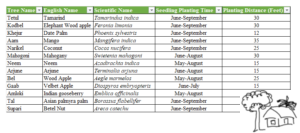Tree plantation in saline-prone areas is very challenging in the present context of Bangladesh. Coastal areas become sub-merged every year during a particular time of the year. Besides, many fruits, medicinal, and fuel wood trees were available in the coastal areas but are currently lost due to extreme salinity. For example, on the roadside of the Sathkhira near Sundarbans, only Date palm, Wood Apple, and Tamarind trees are standing as proof of saline tolerance. Therefore, roadside tree plantations need serious consideration, and use of this high land for planting saline tolerant plants.
Important Points for Tree Plantation in Saline-prone Areas
Firstly, the interest of the local communities must be ensured as the plantation will be done on the roadside. Always there is a possibility of damaging the seedlings by neighboring community people.
Secondly, according to Social Forestry regulations of Bangladesh, the Involvement of Union Parishad, the Forest Department, and local communities must be ensured. A written agreement will serve the purpose of the community people.
Thirdly, the selection of the appropriate tree species is very important as the land is saline-prone. The priority should be given to the tree species which can survive in water-logged conditions for at least 15-60 days a year.

Above all, the local community has to look after the seedlings till the seedlings become big enough for natural protection from livestock. But, in the initial stage, seedlings should be protected by fencing or any other means from livestock and physical damage.
Fourthly, an appropriate distribution mechanism must be enacted for distributing the benefits among stakeholders. It must be included in the agreement document for minimizing any discrimination in the future.
Lastly, all plantations must be done by following the rules and regulations of the Forest Department and local Union Parishad.
“Native habitat such as birds can take shelter in the roadside trees”
Mansur Ahmed
Tree species for roadside plantation
A standard pit measurement (1 meter*1 meter* 1 meter) should be followed during seedlings plantation. In addition, the pit must be prepared before plantation by using cow dung or other fertilizers.
| Tree Name | English Name | Scientific Name | Seedling Planting Time | Planting Distance (Feet) |
| Tetul | Tamarind | Tamarindus indica | June-September | 30 |
| Kodbel | Elephant Wood apple | Feronia limonia | June-September | 30 |
| Khejur | Date Palm | Phoenix sylvestris | June-September | 12 |
| Aam | Mango | Mangifera indica | June-September | 35 |
| Narikel | Coconut | Cocos nucifera | June-September | 25 |
| Mahogoni | Mahogany | Swietenia mahagoni | June-August | 30 |
| Neem | Neem | Azadirachta indica | May-August | 15 |
| Arjune | Arjune | Terminalia arjuna | June-August | 15 |
| Bel | Wood Apple | Aegle marmelos | May-August | 25 |
| Gaab | Velbet Apple | Diospyros embryopteris | June-July | 15 |
| Amloki | Indian gooseberry | Emblica officinalis | May-August | 20 |
| Tal | Asian palmyra palm | Borassus flabellifer | June-September | 30 |
| Supari | Betel Nut | Areca catechu | June-September | 7 |
Finally, the mentioned list of tree species could be considered while planting trees on the roadside of saline-prone areas. However, the list is a living list and it could be changed based on area suitability and local preference. Equally important, roadside tree plantations in saline-prone areas will increase vegetation coverage and play a vital role to mitigate climate change impacts in Bangladesh.


